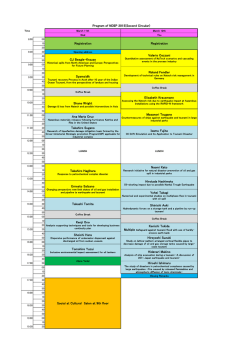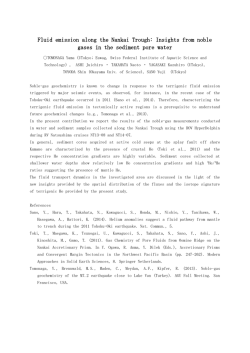
L l i Large scale scouring by the 2011 Tohoku Tsunami Introduction
International Workshop on the Application of Fluid Mechanics to Disaster Reduction February 21, 2014, IRIDeS, Tohoku University Large scale L l scouring i by the 2011 Tohoku Tsunami Akira Mano IRIDeS, Tohoku University 1 Introduction Background: On the Pacific Coast of Tohoku, Japan, the lands are protected by coastal levees, inlet gates, and breakwaters from the hazards of tsunamis, storm surges, and d wind i d waves. Th The 2011 T Tohoku h k T Tsunamii overtopped t d almost l t allll these structures and brought huge amount sea water onto the hinterlands. The water soon started to return to the sea and scoured the lands on a large scale especially near the structures structures. Such scouring retards the 2km reconstruction of the structures and recovery from the disaster. Purposes are to know the scouring process and mechanism to develop the tool to predict the scouring to find better way to control the scouring * 2km 2 Location Map 2km * Sendai Bay area 3 Sankiku Coast Yamamoto Coast 2km Before the tsunami (Photo March 2010) Coastal erosion, T-shape jetties, Nourishment After the tsunami(Photo 19 March 2011) 4 2km Dense breach, tsunami bay, tsunami channel Minami-Snariku-Cho, Shizugawa Bay From left, left Mizushiri R., R Hachiman R., R and Nitta R R. 2km Before the tsunami (25 July 2010) After the t tsunami i (14 March 2011) * 2km 5 Minami-Sanriku-Cho, Sizugawa Bay Hachiman River 津波前 (2010年6 月25日) 2km After the tsunami (20 March 2011) Before the tsunami (25 July 2010) * 2km 6 Sakamoto River, Yamamoto Coast 津波前 (2010年6 月25日) 2km After the tsunami (14 M March h 2011) Before the tsunami (10 D December b 2009) * 2km 7 Ootsuchi R. and Kotsuchi R., Ootsuchi Bay Railway bridge at left bank 2km2000) (Photo, After the tsunami (24 Marchi 2011) Railwayy bridge g at left bank (Photo 2007) 8 2km Scouring process, Yamamoto Coast Sea Land Capture of tsunami video Breaking of the coastal levee Tsunami profile at Abukuma gate and the phase of the video shooting 9 Scouring process, Abukuma River mouth Return flow from the breach point 河川堤防の被災状況 Large scale scouring behind the levee 海岸堤防の被災状況 10 Scouring process, Fujitsula Return flow trace from the breach point Scouring by the tsunami 3m scouring behind the levee Scatter of the armor blocks 11 Scouring at ditches, Yamamoto Coast formation of tsunami bay 12 Mechanisms of large scale scouring First step:impact p p of the first wave surge g Break of the levee parapet or at the joint Huge amount of seawater inflow to the land Second step: Scouring by the flow concentration at the break points beyond the ditches 13 West Prediction of large scale scouring Review 1: The report of the 2004 Indian Ocean Tsunami Tsunami Inundation Scour of Roadways, Bridges, and Foundations, Observations Technical Guidance from Great Sumatra Andaman Tsunami EERI/FEMA NEHRP2006 Professional Fellowship Report Principal Advisor: Harry Yeh, Oregon State University Excessive pore pressure in sand layers leads liquification and then deeper scouring. The report concludes that this mechanism is extremely y high g to cause the scouring. Marina Beach, Chennai Arugam Bay Bridge, Sri Lanka Kamala Beach, Phuket Prediction of large scale scouring Review 2:Tonkin et al al.(2003) (2003) Tsunami scour around a cylinder cylinder, Journal of Fluid Mechanics, vol. 496, pp. 165-192, 2003 S. Tonkin, H. Yeh, F. Kato, and S. Sato Wave surface, velocity, pore pressure in the bottom sand were measured for solitary wave. Since the maximum scouring occurred for smaller velocity, liquification due to excessive pore pressure is concluded to be the major cause of the scouring. scouring 15 Prediction of large scale scouring Review 3:Pan et al al.(2012) (2012) Numerical modeling of tsunami wave run run-up up and effects on sediment scour Around a cylindrical pier, Journal of Engineering Mechanics,2012.138.1224-1235 C. Pan and W. Huang, Zhejiang Institute of Hydraulics and Estuary, China. Pan et al. conducted numerical simulation of the Tonkin’s experiment(2003)by the shallow water equations, suspended sediment transport equation with erosion by the bed shear stress. They can reproduce 8cm scouring out of the maximum 15cm. Two mechanisms of scouring are ・excessive pore pressure ・bottom shear stress 16 Our model on the scouring Iid (2014) Iida The shallow water equations Quasi-3D sediment transport equation C 1 q sx 1 q sy C q x q y D y D x t D x y C C w0 C a Cbottom s H11号 s x x y y D where C is vertically averaged concentration of the suspended sediment with assuming the equilibrium vertical profile of Rouse. Reference concentration by Van Rijn(1993) is adopted, C a 0.015 d 0.3 c D* a c 1.5 with Shields parameter 17 Finite Volume Meshing at Fujitsuka area H11号 18 Surface elevation and velocity 30 minutes from the start H11号 Surface elevation Velocity and stream lines 19 Scouring depth 30 minutes from the start H11号 Computed. Maximum depth, 10m Observed on March 12, 2011. The maximum depth is about 6 m obtained from the trench survey. 20 Conclusions We find the mechanisms of the large scale scouring. We develop the quasi-3D sediment transport model which reproduces the scouring qualitatively. Further studies are to quantify the scouring by shear stress and pore pressure H11号 to reproduce tsunami channels and bays by the simulation to find better way to control the scouring 21 最後に Thank you 流れのモデル • 非線形浅水流方程式 qx q y 0 y x t • 2q 2qx bx q x uq x uq y gD t 2x x t x y x y 2 2q y 2q y by t q y vq x vq y gD x 2 t x y y y 2 底面せん断力 2 bx • n g D 73 q x q x2 q 2y , by 渦動粘性係数 12 t 0.11 ng D 16 n 2 g D 73 q x q x2 q 2y x,y:直交座標 η:水位 水位 qx,qy:x,y方向それぞれ の単位幅流量 u,v:x,y方向それぞれの 水深平均流速 g:重力加速度 D:水深 ρ:流体の密度 流体の密度 (=1000kg/m3) τbx,τby:x,y方向それぞれ の底面せん断応力 νt:水深平均渦動粘性係数 n:Manningの粗度係数 q x2 q 2y 23 2013/10/18 Mゼミ 河床変動モデル • 河床変位計算 Z b 1 Cbottom C a w0 t 1 • Rouseの濃度分布式 C 1 Cbottom 1 z a* • 1 z a* 1 z * z * * 1, z a z a* Ro Ro ddz * w0 u* 土砂輸送方程式 C 1 q sx 1 q sy C q x q y t D x D y D x y C C w0 Ca Cbottom s s x x y y D • 巻き上げ計算(van Rijn, 1993) C a 0.015 d 0.3 c D* a c 1.5 2013/10/18 Mゼミ Zb:河床高 λ:空隙率(=0.4) Cbottom:基準点沈降濃度 Ca:基準点巻き上げ濃度 w0:土粒子の沈降速度 土粒子の沈降速度 C:水深平均土砂濃度 za*:無次元基準点高さ Ro:Rouse数 κ:カルマン定数(=0.4) qsx,qsy:x,y方向それぞれの 単位幅土砂流量 εs:水深平均拡散係数 水深平均拡散係数 d:土砂粒径 D*:無次元土砂粒径 θ:無次元せん断力( 無次元せん断力(=ρu ρu*2/(ρs-ρ)gd ρ)gd) ρs:土粒子の密度 θc:限界無次元せん断力 a:係数(=Δ/2=50d) Δ:河床波の高さ 河床波の高さ 24
© Copyright 2026

